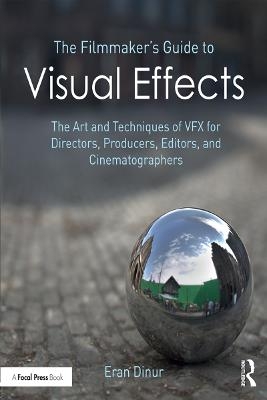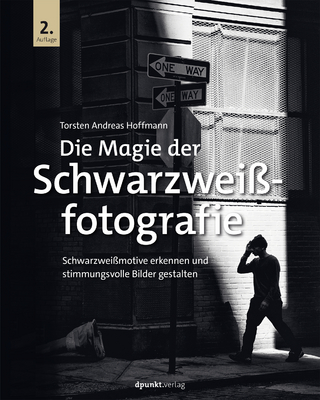
The Filmmaker's Guide to Visual Effects
Routledge (Verlag)
978-0-415-40199-9 (ISBN)
- Titel ist leider vergriffen;
keine Neuauflage - Artikel merken
The book will help readers:
Learn what it takes for editors, cinematographers, directors, producers, gaffers, and other filmmakers to work more effectively with the visual effects team during pre-production, on the set and in post, use visual effects as a narrative aid, reduce production costs, and solve problems on location;
Achieve a deeper understanding of 3D, 2D and 2.5D workflows; the various vfx crafts from matchmove to compositing; essential concepts like photorealism, parallax, roto and extraction; become familiar with the most common types of VFX, their role in filmmaking, and learn how to plan effectively for the cost and complexity of VFX shots;
See visual effects concepts brought to life in practical, highly-illustrated examples drawn from the real-world experiences of industry professionals, and discover how to better integrate visual effects into your own projects.
Eran Dinur is an Emmy and VES Award-winning VFX supervisor, artist and instructor. His work at ILM Singapore includes films such as Iron Man, Star Trek, Transformers: Revenge of the Fallen, Indiana Jones and the Kingdom of the Crystal Skull, and Terminator Salvation. Since 2011 Eran has served as the VFX supervisor of NYC-based company Brainstorm Digital on numerous film and TV projects, including The Wolf of Wall Street, Boardwalk Empire, The Lost City of Z, Café Society, Nerve, Delivery Man, The Heat, The Men Who Built America, and The Immigrant. Eran won a Primetime Emmy Award as well as two Visual Effects Society Awards for his work on Boardwalk Empire. Eran teaches VFX production skills at the School of Visual Arts, has created popular online courses at fxphd, has written numerous articles for 3D World Magazine, and has presented at various international conferences including SIGGRAPH, NAB, and Mundos Digitales.
Table of Contents
Introduction
Part 1: Visual effects overview
Visual effects in contemporary film & TV
The invisible art of supporting VFX
Why use VFX?
VFX as a story-telling tool
Reducing costs
Creating the impossible
Fixing mistakes
Supporting the visual language
CGI: preconceptions and misconceptions
Visual effects in production: 3 case studies
Case study 1
Case study 2
Case study 3
Working with Key people in the VFX team
The VFX supervisor
The VFX producer
3D, 2D and 2.5D
Camera movement and parallax
Working in 2D
Working in 3D
"Fake" 3D: 2.5D projections
2D or 3D? Advantages and disadvantages
Part 2: VFX in depth
Introduction
The VFX chain in small and large facilities
2D tracking & Match move
2D tracking
Camera tracking
Modeling
Hard surface modeling
Organic modeling
Texturing
Shading & lighting
Shaders
Direct and ambient lights
Global illumination, ambient occlusion and HDRI
Animation
Technical animation
Character animation
Motion capture
Rigging
Simulations
Hard-body
Particles
Fluid
Cloth
Matte painting
Compositing
Rotoscoping
Keying
The final stage – how everything comes together
Compositing as a VFX powerhouse for the budget-conscious
Part 3: photorealism
Introduction
The search for clues
The integration checklist
Context
Movement and motion blur
Perspective
Light
Depth and atmosphere
Color
Focus
Optical phenomena
Grain
Part 4: Preproduction
Script-based VFX breakdown
Storyboarding
The bidding process
Initial meetings with the VFX team
Location scouting with the VFX team
Previz
Planning the shoot
Part 5: On set
The importance of a second unit
Shooting Green/blue screens
Crowd tiling
VFX vs. SFX
Dos and don’ts
Part 6: Postproduction
Understanding delivery formats
Establishing the color pipeline
The reviewing process
RND, assets, style frames and temps
The approval stages
Turntable
Layout
Primary animation
Secondary animation
AO
Textured
Final
Effective communication with the VFX team
The DI review
Glossary
| Erscheint lt. Verlag | 10.5.2017 |
|---|---|
| Verlagsort | London |
| Sprache | englisch |
| Themenwelt | Kunst / Musik / Theater ► Film / TV |
| Kunst / Musik / Theater ► Fotokunst | |
| Sachbuch/Ratgeber ► Freizeit / Hobby ► Fotografieren / Filmen | |
| Technik ► Architektur | |
| ISBN-10 | 0-415-40199-2 / 0415401992 |
| ISBN-13 | 978-0-415-40199-9 / 9780415401999 |
| Zustand | Neuware |
| Informationen gemäß Produktsicherheitsverordnung (GPSR) | |
| Haben Sie eine Frage zum Produkt? |
aus dem Bereich


